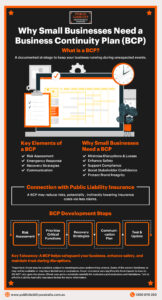 A Business Continuity Plan (BCP) serves as a proactive strategy to help your business remain operational and resilient in the face of unexpected disruptions.
A Business Continuity Plan (BCP) serves as a proactive strategy to help your business remain operational and resilient in the face of unexpected disruptions.
While insurance policies like public liability insurance may help cover specific risks, a BCP aims to prevent or mitigate the impact of these risks altogether. For small businesses in Australia, having a solid BCP is not only a good practice but a potentially crucial measure for safeguarding their long-term stability.
What is a Business Continuity Plan (BCP)? *
A BCP is a documented strategy that outlines procedures and actions a business will take to continue critical functions during and after an unexpected event. Whether it’s an accident, injury, pandemic, or a cyber-attack, a BCP prepares your business to face these challenges with minimal disruption.
Key components of a BCP typically include:
- Risk Assessment and Impact Analysis: Identifying potential threats and evaluating their impact on business operations.
- Emergency Response Planning: Procedures for responding to incidents, including evacuation plans and emergency contacts.
- Recovery Strategies: Plans for restoring critical operations and getting the business back to full function.
- Communication Plans: Establishing clear lines of communication during a crisis to inform stakeholders and employees.
Why is a Business Continuity Plan Important for Small Businesses? *
Small businesses are particularly vulnerable to unexpected events due to their typically smaller workforce and limited resources. A BCP provides several key benefits that are vital for business continuity and stability:
- Minimises Operational Disruptions and Financial Losses
When disaster strikes, it’s the businesses that are unprepared that face the longest recovery times. A well-developed BCP can help reduce downtime, ensuring that core functions remain active and limiting financial losses. By identifying which business processes are critical, owners can allocate resources effectively to maintain operations during a crisis. For example, for a retail store owner, a BCP might prioritise ensuring point-of-sale systems remain operational during a power outage by having backup generators in place and training staff on manual payment methods. - Reduces Risk and Enhances Safety Measures
Having a BCP helps small businesses identify areas of vulnerability and implement risk-reduction measures. This proactive approach not only minimises disruptions but can also prevent accidents or incidents that might otherwise lead to claims under public liability insurance. For example, an effective BCP may include enhanced workplace safety procedures or improved communication protocols, reducing the likelihood of accidents. For example, for an electrical contractor, a BCP could include measures such as regular equipment safety checks, implementing clear protocols for handling live wires during emergencies, and training staff on first-aid procedures to mitigate the risks of workplace injuries. - Supports Compliance with Regulatory Requirements
In Australia, many industries have legal obligations to ensure that businesses can manage risks and protect their workforce. A BCP helps you stay compliant by documenting how your business addresses risks and safety concerns. This can be crucial if your business faces audits or investigations after an incident. - Improves Customer and Stakeholder Confidence
Demonstrating that your business is prepared for emergencies instils confidence in customers, suppliers, and other stakeholders. It shows that you are committed to delivering reliable services and have taken steps to protect their interests in times of crisis. - Protects Reputation and Brand Integrity
When a business fails to respond effectively to a crisis, it risks damaging its reputation and losing customer trust. A BCP ensures that you have strategies in place to communicate transparently and manage public relations effectively, protecting your brand in difficult times.
How Does a BCP Relate to Public Liability Insurance? *
While a BCP and public liability insurance serve different purposes, they are complementary. A BCP focuses on preventing disruptions, while public liability insurance may cover legal costs and compensation if your business causes injury or property damage to a third party. By reducing risks and having contingency plans, you may potentially lower the number of claims made under public liability insurance, which in turn may help reduce premium costs.
For example, if your BCP includes enhanced safety protocols or quick-response measures for dealing with emergencies, you are better equipped to avoid accidents that could lead to claims. With fewer claims, insurance providers may view your business as lower risk which may result in favourable premium pricing. Of course, speak with our public liability insurance brokers to get an understanding of how a BCP may affects your business insurance both directly and indirectly.
Developing a Business Continuity Plan *
Creating a BCP for your business involves several steps, starting with assessing your current risks and vulnerabilities. Here’s a simplified process to help you get started:
- Conduct a Risk Assessment
Identify the key risks that could disrupt your business operations. This could include accidents, injuries to employees and others, cyber incidents, or supply chain issues. Evaluate the potential impact on your business, including financial losses and operational downtime. - Prioritise Critical Functions
Determine which functions are essential to your business’s survival. Prioritising these allows you to focus your resources where they are needed most during a crisis. - Develop Recovery Strategies
Outline steps for maintaining or quickly restoring critical operations. Consider alternative locations, equipment, or processes that could serve as a temporary replacement during a disruption. - Create a Communication Plan
Establish a system for keeping employees, customers, and suppliers informed during an emergency. This helps maintain transparency and trust during uncertain times. - Test and Update the Plan Regularly
A BCP should be a living document that is tested, reviewed, and updated regularly to remain relevant. Conduct regular drills and gather feedback to identify areas for improvement.
Conclusion*
For small businesses in Australia, a Business Continuity Plan is recommended. A comprehensive BCP may help protect your business from the financial and operational impacts of unexpected events. It complements public liability and other business insurance by reducing risks and potentially lowering insurance costs if you have less claims as a result.
Investing time and resources into developing a BCP could save your business from substantial disruptions, loss of revenue, and reputational damage. Most importantly, it provides peace of mind, knowing that your business is prepared to handle whatever challenges may come its way.
Disclaimer: The content of this blog article is intended for general informational purposes only and should not be considered as professional advice. While we strive to ensure accuracy, we make no guarantees about the completeness or reliability of the information. For guidance regarding what and how much public liability insurance cover you need, we recommend consulting with a business insurance broker. Any actions you take based on any information provided here are at your own discretion.





